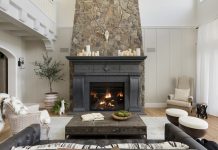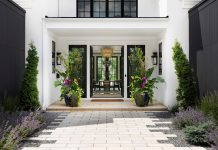Photos by LandMark Photography, Jim Kruger, and Jon Huelskamp

He’s from the Netherlands, and likes classic design and compartmentalized rooms. She’s from Venezuela, and loves rich textures and vibrant colors. The two have traveled around the world, spending time living in other countries including China and Colombia, collecting art and gaining appreciation for many different design styles along the way. When their busy and adventurous life eventually led them to Minnesota, the couple knew they had the opportunity to make a new home, one that reflected their shared lifetime of experiences, memories, and blended cultures.

But how do you create a home as interesting as these particular homeowners? The answer is to bring together a design team as experienced and unique as their clients. In this case, that team included local boutique architecture and design firm Eskuche Design Group, luxury home builder Hendel Homes, and Studio Brown Bag, a Chicago-based interior design firm led by two designers who also hail from Venezuela.
After the team was assembled, it was time to make the couple’s vision for their new home a reality. “Their exact words were, ‘We would like a contemporary interpretation of a classic design,’” says Peter Eskuche, owner and principal of Eskuche Design Group. “That was the biggest part of the design concept. The second was the idea of a homecoming—because they have family all over the world, they wanted their home to be a place where everyone could come together. We actually named it ‘Thuiskomst,’ the Dutch word for ‘homecoming,’ because this was so important to them.”

With a large extended family, the home needed to be roomy enough to accommodate guests for longer periods of time. At 12,000 square feet and boasting three levels, seven bedrooms, 10 bathrooms, and a pool house, it’s safe to say the finished Orono home on the shores of Lake Minnetonka not only meets the goal, but does so with unmistakable flair. “It’s a multi-generational home—we had three generations staying in it at one point,” says Eskuche. “It’s just full of life, and the owners use every inch of it.”

The team artfully blended elements of Dutch architecture (steep rooflines, narrow casement windows, and lots of gable ends) with South American design influences for a modern-yet-classic exterior with a colorful, luxe interior full of intimate spaces and self-contained entertainment areas. “They didn’t want an open-concept home,” explains Amy Hendel, co-owner of Hendel Homes, whose team enjoyed the opportunity to build something unique in Minnesota. “They loved defined rooms and the idea of being able to discover different areas as you walk through the home, so while there’s great flow, there’s also an individual sense of what each room is and what purpose it serves.”

With pieces curated from around the globe, the couple’s impressive and eclectic collection of art factored heavily into the interior design of their home. While additional works were custom-created for some rooms, other areas of the home were specifically designed to highlight certain pieces of art. “The butterfly piece is a perfect example,” says Aniuska Payares, one of the design directors of Studio Brown Bag. “We found the artwork and knew it would be for her [the wife of the couple]. We didn’t know where it would go at first, but then we ended up designing her entire office around that particular piece. Whereas the frame of the woman in the family room was an opposite situation—we designed the space first, and the art just happened to fit right in.”

Cory Gonzalez, the other creative mind behind Studio Brown Bag, also mentioned how the couple admired a certain artist from China, but he didn’t have something in the colors they wanted. “We sent him the fabrics we were using for the space, and he created two options for us,” Gonzalez says. “That’s how we got the round, blue-green piece in the living room.”
In fact, designing a home to highlight works of art was one of Eskuche’s favorite parts of the project, and he and his team came up with myriad ways to showcase pieces, from carefully designing niches and soffits to frame works to finding the best places and ways to incorporate lighting. “You want the architecture of the home to be fairly simple so it won’t take away from the décor, so in some ways we were really practicing a lot of restraint in the architecture so it could enable the art to sing,” he says. “That’s kind of the opposite of what we typically do: when we try to make every room extraordinary, every room a hero. Instead, we focused on creating a tasteful canvas to allow the owners’ art and objects to be layered in, from using laser panels in the foyer to highlight a painting to installing glass railings in the stairwell designed to lead the eye to the art at the end.”

“I love the painting we have at the bottom of the stairway—you’d never expect that painting there. It’s like it’s saying, ‘Down here, we’re going to have fun!’” Payares says, laughing. [The painting she’s referencing is a playful portrait of a Breakfast at Tiffany’s-style Audrey Hepburn blowing a bright blue bubble.]

The main entertaining spaces and private offices can be found back on the main level, with the majority of bedrooms located upstairs and a home theater and additional bunk room downstairs. Colors ebb and flow throughout the space: Shimmering blues and greens in the living room lead to deeper greens and hints of orange and red in the eat-in kitchen, while brighter reds, oranges, and gold tones can be found in an adjoining den, a cozy spot for the family (big fans of the Amsterdam soccer team) to watch matches together.


The kitchen was an extremely important space for the entertaining-loving owners. To enhance their kitchen experience, the designers added thoughtful additional spaces like a scullery/prep kitchen (perfect for hiding appliances) and a porch with retractable screens located right off the kitchen for guests to enjoy a casual outdoor dining area. “We purposely created the porch to be shallow so you don’t lose a lot of sunlight, and wide to accommodate larger groups of people,” explains Eskuche, who designed the porch to lead the eye down to the pool area and pool house located off the lower level.



Luxe finishes such as Cambria countertops, intricate tilework, and rich fabrics subtly enhance each space—an intentional design choice Studio Brown Bag made to create cohesiveness throughout the home. “Everywhere you look, you see something different—we used an immense variety of tiles, wallpapers, and wood sections; even the floors have different colors and patterns,” says Payares. “But we made sure everything leads from one area to the next. Each time you enter a room, it’s completely different from the last one you were in, but similar elements are carried throughout to balance the entire space.”
And the international design influences don’t end with just the owners and team—cabinetry and millwork were done by Italian company Scavolini, Romo fabrics and textiles were sourced from the United Kingdom, and draperies and window treatments were designed by Florida-based company Drapes by Fanny—whose founder is originally from Uruguay. “I call it the international boutique hotel home,” Hendel laughs. “Kind of like a resort you don’t have to leave.”




















